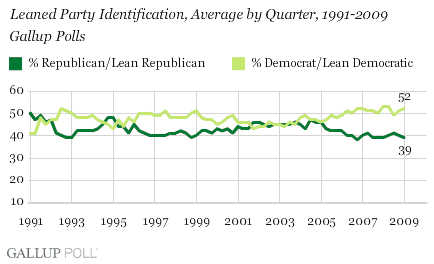PRINCETON, NJ -- Gallup Polls conducted in the first quarter of 2009, from January through March, find an average of 35% of Americans identifying themselves as Democrats and 28% as Republicans. The seven-point gap is similar to what Gallup has found since 2006, when the political tide turned in the Democrats' favor.

In fact, there has been no change in national partisanship since the last quarter of 2008, when 35% of Americans identified as Democrats, 28% as Republicans, and 35% as independents. That means the Democratic Party's advantage has neither expanded nor contracted since Barack Obama took office and began to pursue a largely Democratic legislative agenda.
Democrats enjoyed similar advantages over Republicans in terms of party identification in 1992-1993 and again in the late 1990s.
Since the fourth quarter of 2006, the percentage of Americans identifying as Republicans has consistently been below 30%. During this time, Democrats won big victories in the 2006 midterm elections, which gave them party control of Congress, and won back the White House while expanding their majorities in both houses in the 2008 elections.
The Democrats are now poised to enjoy a working Senate majority of 60 seats after Pennsylvania Sen. Arlen Specter's switch from Republican to Democrat and the probable victory of Democrat Al Franken in the disputed Senate election in Minnesota. A majority of 60 seats is enough to overcome the use of a filibuster to defeat or delay a vote on legislation, and means Democrats could essentially pass any legislation they want as long as their coalition votes together.
The Democratic advantage in partisanship expands to double digits once the political leanings of independents are taken into account. Aggregated data from the first quarter of 2009 show that 52% of Americans identified as Democrats or said they were independent but leaned to the Democratic Party, while 39% identified as Republicans or leaned Republican.
That 13-point Democratic advantage is among the highest Gallup has found since 1991, when it began regularly measuring leaned party identification.

In the final quarter of 2008, leaned party identification was 51% Democrat and 40% Republican, so the Democratic advantage on this measure has increased slightly since Obama took office.
Bottom Line
The immediate outlook for the Republican Party is certainly bleak, with the Democratic Party maintaining significant advantages over it by almost any measure, perhaps most importantly in national party identification. Americans clearly have not reacted in a negative way to Obama's approach to governing, as he enjoys approval ratings above 60% -- better than those of most recent presidents.
It could be a while before Republicans are able to regain a majority in Congress, but they may be able to begin chipping away at the Democratic majority as soon as the 2010 midterm elections, especially considering that the president's party usually loses seats at midterm.
While it is probably not likely that history will repeat itself, it is notable that Democrats held the same seven-point advantage in party identification that they enjoy now in the first quarter of 1993, when Bill Clinton took office. By the time of the 1994 midterm elections, the parties were back to even on national partisanship and Republicans won enough seats to take control of both houses of Congress.
Survey Methods
Results are based on aggregated data from several polls, each consisting of interviews with approximately 1,000 national adults, aged 18 and older, conducted between January and March 2009. For each poll, one can say with 95% confidence that the maximum margin of sampling error is ±3 percentage points.
Interviews are conducted with respondents on land-line telephones (for respondents with a land-line telephone) and cellular phones (for respondents who are cell-phone only).
In addition to sampling error, question wording and practical difficulties in conducting surveys can introduce error or bias into the findings of public opinion polls.
